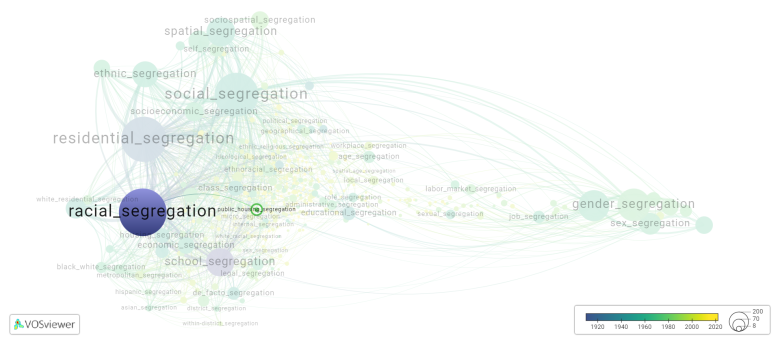Public housing segregation: Difference between revisions
(Creating page) |
(Creating page) |
||
| Line 19: | Line 19: | ||
Public housing segregation is frequently discussed in the literature with the following segregation forms: | Public housing segregation is frequently discussed in the literature with the following segregation forms: | ||
[[ | [[racial segregation]], [[social segregation]] | ||
[[File:public_housing_segregation.png|780x780px]] | [[File:public_housing_segregation.png|780x780px]] | ||
| Line 25: | Line 25: | ||
For the complete network of associated segregation forms, see: | For the complete network of associated segregation forms, see: | ||
year of publication https://tinyurl.com/2235lkhw | |||
Louvain clusters https://tinyurl.com/2d8wg5n3 | |||
betweenness centrality https://tinyurl.com/223udk5r | |||
disciplines where segregation forms first appeared https://tinyurl.com/244d8unz | |||
==References== | ==References== | ||
==Notes== | ==Notes== | ||
Revision as of 14:38, 27 September 2024
Date and country of first publication[1]
1989
United States
Definition
Public housing segregation refers to the practice of segregating public housing communities based on race, ethnicity, or socioeconomic status. This practice has its roots in historical policies and practices that perpetuated racial and socioeconomic disparities in housing.
During the mid-20th century, many cities in the United States implemented segregationist housing policies that restricted African Americans and other minority groups from accessing housing in predominantly white neighborhoods. This led to the creation of public housing projects primarily located in low-income, racially segregated areas. These projects were often characterized by poor living conditions, limited amenities, and lack of community resources.
The Federal Housing Administration (FHA) further reinforced public housing segregation by implementing redlining policies. Redlining involved rating neighborhoods based on their perceived level of risk for lenders, with minority neighborhoods often designated as high-risk. Consequently, access to financing and homeownership opportunities in these neighborhoods was limited or denied altogether.
Over time, public housing projects became disproportionately occupied by minority communities, perpetuating racial and socioeconomic segregation. This segregation further exacerbated social and economic inequalities, as public housing communities often lacked access to quality education, healthcare, and employment opportunities.
Efforts have been made to address and mitigate public housing segregation. The Fair Housing Act of 1968 prohibits housing discrimination based on race, color, religion, sex, or national origin. Additionally, the Department of Housing and Urban Development (HUD) has developed programs and initiatives aimed at promoting fair housing practices and reducing segregation in public housing.
However, despite these efforts, public housing segregation still persists to varying extents in many cities across the country. Housing policies, discriminatory practices, and systemic inequalities continue to contribute to the perpetuation of segregated public housing communities. Addressing this issue requires comprehensive efforts that tackle structural inequalities, increase affordable housing options in diverse neighborhoods, and promote equitable access to resources and opportunities for all residents.
See also
Related segregation forms
Public housing segregation is frequently discussed in the literature with the following segregation forms:
racial segregation, social segregation

For the complete network of associated segregation forms, see:
year of publication https://tinyurl.com/2235lkhw
Louvain clusters https://tinyurl.com/2d8wg5n3
betweenness centrality https://tinyurl.com/223udk5r
disciplines where segregation forms first appeared https://tinyurl.com/244d8unz
References
Notes
- ↑ Date and country of first publication as informed by the Scopus database (December 2023).
At its current state, this definition has been generated by a Large Language Model (LLM) so far without review by an independent researcher or a member of the curating team of segregation experts that keep the Segregation Wiki online. While we strive for accuracy, we cannot guarantee its reliability, completeness and timeliness. Please use this content with caution and verify information as needed. Also, feel free to improve on the definition as you see fit, including the use of references and other informational resources. We value your input in enhancing the quality and accuracy of the definitions of segregation forms collectively offered in the Segregation Wiki ©.
Public housing segregation appears in the following literature
Goering J.M., Coulibably M. (1989). Investigating Public Housing Segregation: Conceptual and Methodological Issues. Urban Affairs Review, 25(2), 265-297. https://doi.org/10.1177/004208168902500205
Chandler M.O. (1992). Public Housing Desegregation: What Are the Options?. Housing Policy Debate, 3(2), 509-534. https://doi.org/10.1080/10511482.1992.9521102
Goering J.M. (1993). Towards the Comparative Exploration of Public Housing Segregation in England and the United States1. Housing Studies, 8(4), 256-273. https://doi.org/10.1080/02673039308720767
Popkin S.J., Galster G.C., Temkin K., Herbig C., Levy D.K., Richer E.K. (2003). Obstacles to Desegregating Public Housing: Lessons Learned from Implementing Eight Consent Decrees. Journal of Policy Analysis and Management, 22(2), 179-199. https://doi.org/10.1002/pam.10112
Hanlon J. (2015). Fair Housing Policy and the Abandonment of Public Housing Desegregation. Housing Studies, 30(1), 78-99. Routledge.https://doi.org/10.1080/02673037.2014.933781
Verdugo G., Toma S. (2018). Can Public Housing Decrease Segregation? Lessons and Challenges From Non European Immigration in France: Can Public Housing Decrease Segregation?. Demography, 55(5), 1803-1828. Springer Science and Business Media, LLC.https://doi.org/10.1007/s13524-018-0705-4
